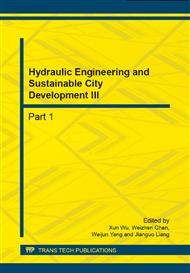[1]
Q. Wang, J. Yang, M. Ren, et al. Driver Fatigue Detection: A Survey[C]/The 6th World Congress on Intelligent Control and Automation. Dalian, China, 2006: 8587–8591.
DOI: 10.1109/wcica.2006.1713656
Google Scholar
[2]
King L M, Nguyen H T, Lal S K L. Early Driver Fatigue Detection from Electroencephalography Signals using Artificial Neural Networks. Proceedings of the 28th IEEE EMBS Annual International Conference, New York City, USA, 2006: 2187~2190.
DOI: 10.1109/iembs.2006.259231
Google Scholar
[3]
Tran Y, Wijesuryia N, Thuraisingham R A, et al. Increase in Regularity and Decrease in Variability Seen in Electroencephalography(EEG) Signals from Alert to Fatigue During a Driving Simulated Task. 30th Annual International IEEE EMBS Conference, Vancouver, BC, 2008: 1096~1099.
DOI: 10.1109/iembs.2008.4649351
Google Scholar
[4]
Jeong I C, Lee D H, Park S W, et al. Automobile Driver's Stress Index Provision System that Utilizes Electrocardiogram[C]/IEEE Intelligent Vehicles Symposium, 2007: 652-656.
DOI: 10.1109/ivs.2007.4290190
Google Scholar
[5]
Jiao Kun, Li Yong, Chen Ming, Wang Chengtao. Driving Mental Fatigue and Heart Rate Variability Analysis of the Combined Effect of Blood Pressure Variability. [J]. Biological Journal of Medical Engineering, 2005, 22 (2) : 127-130.
Google Scholar
[6]
Yang Yu book, Zhen-Qiang Yao, Li Yong, etc. Effectiveness of Frequency-Domain ECG Indicators When Driving Fatigue Evaluation [J]. Mechanical design and manufacturing, 2002 (5) : 94-95.
Google Scholar
[7]
Li Zhen, FENG Xiao-yi. Summary of Driver Fatigue Detection Method based on Sensor Technology. Measurement and Control Technology, 2007, 26 (4) : 1-3.
Google Scholar
[8]
Zheng Pei, Song Zhenghe, Zhou Yiming. Driving Motor Vehicle Driver Fatigue Evaluation Method Research Status and Development Trend [J]. China Agricultural University, 2001, 6 (6) : 101-105.
Google Scholar
[9]
Wang Feng, Meng Zhe, Granville. Development of DSP-based Driver Fatigue Detector [J]. Medical equipment, 2005, 18 (12) : 9-12.
Google Scholar
[10]
Mao Zhe, Chu Xinmin, Yan Xinping, et a1. Advances of Fatigue Detecting Technology for Drivers[J]. China Safety Science Journal, 2005, 15(3): 108-l12. (in Chinese).
Google Scholar
[11]
Sun Wei, Li Xiaoying. Avoid fatigue driving, The Driver Warning System., Traffic World (transport vehicles), 2006 (1): 57.
Google Scholar
[12]
Sandberg D, Wahde M.Particle Swarm Optimization of Feedforward. Neural Networks, 2008.IJCNN 2008, Hong Kong, China, 2008: 788-793.
Google Scholar
[13]
Sun Wei, Li Xiaoying. Driver Warming System, to Prevent Tired Driving[J]. Transpo World, 2006, 1(19): 57. (in Chinese).
Google Scholar
[14]
Sun Wei, Zhang Weigong, Zhang Xiaorui, et al. Research Progross of Fatigue Driving Early Warning System[J]. Auto Electric Parts, 2009(1): 5-8. (in Chinese).
Google Scholar


